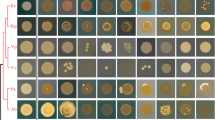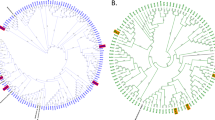Abstract
A dual culture-based and non–culture-based approach was applied to characterize predator bacterial groups in surface water samples collected from Apalachicola Bay, Florida. Chemotaxis drop assays were performed on concentrated samples in an effort to isolate predator bacteria by their chemotactic ability. Yeast extract (YE) and casamino acids (CA) proved to be strong chemoattractants and resulted in three visibly distinct bands; however, dextrose, succinate, pyruvate, and concentrated cells of Vibrio parahaemolyticus P5 as prey did not elicit any response. The three distinct bands from YE and CA were separately collected to identify the chemotactic microbial assemblages. Plaque-forming unit assays from different chemotaxis bands with P5 as prey indicated 5- (CA) to 10-fold (YE) higher numbers of predator bacteria in the outermost chemotactic bands. Polymerase chain reaction–restriction fragment length polymorphism and 16S rDNA sequencing of clones from different chemotaxis bands resulted in identification of Pseudoalteromonas spp., Marinomonas spp., and Vibrio spp., with their numbers inversely proportional to the numbers of predators—i.e., Bdellovibrio spp. and Bacteriovorax spp—in the chemotaxis bands. This study indicates that predatorial bacteria potentially respond to high densities of microbial biomass in aquatic ecosystems and that chemotaxis drop assay may be an alternate culture-independent method to characterize predatorial bacterial guilds from the environment.





Similar content being viewed by others
Literature Cited
Altschul SF, Gish W, Miller W, Myers EW, Lipman DJ (1990) Basic local alignment search tool. J Mol Biol 215:403–410
Bhushan B, Samanta SK, Chauhan A, Chakraborti AK, Jain RK (2000) Chemotaxis and biodegradation of 3-methyl-4-nitrophenol by Ralstonia sp. SJ98. Biochem Biophys Res Commun 275:129–133
Chauhan A, Ogram A (2006) Fatty acid-oxidizing consortia along a nutrient gradient in the Florida Everglades. Appl Environ Microbiol 72:2400–2406
Chauhan A, Ogram A, Reddy KR (2004) Syntrophic-methanogenic associations along a nutrient gradient in the Florida Everglades. Appl Environ Microbiol 70:3475–3484
Cole JR, Chai B, Marsh TL, Farris RJ, Wang Q, Kulam SA, et al. (2003) The Ribosomal Database Project (RDP-II): Previewing a new autoaligner that allows regular updates and the new prokaryotic taxonomy. Nucleic Acids Res 31:442–443
Dworkin M (2005) Prokaryotic life cycles. In: Dworkin M, et al. (eds) The prokaryotes: An evolving electronic resource for the microbiological community, 3rd ed. Online BETA–release 3.20 (12/31/2005)
Jerkovitch E (2000, November 2) The Genus Bdellovibrio. In: Dworkin M, et al. (eds) The prokaryotes: An evolving electronic resource for the microbiological community, 3rd ed. Release 3.7. New York, NY, Springer-Verlag. Available at: http://link.springer-ny.com/link/service/books/10125/
Kelley JI, Williams HN (1992) Bdellovibrios in Callinectus sapidus, the blue crab. Appl Environ Microbiol 58:1408–1410
LaMarre AG, Straley SC, Conti SF (1997) Chemotaxis toward amino acids by Bdellovibrio bacteriovorus. J Bacteriol 131:201–207
Lambert C, Smith MC, Sockett RE (2003) A novel assay to monitor predator-prey interactions for Bdellovibrio bacteriovorus 109 J reveals a role for methyl-accepting chemotaxis proteins in predation. Environ Microbiol 5:127–132
Lane DJ (1991) 16S/23S rRNA sequencing. In: E. Stackebrandt E, Goodfellow M (eds) Nucleic acid techniques in bacterial systematics. New York: NY, Wiley, pp 115–175
Pineiro SA, Sahaniuk GE, Romberg E, Williams HN (2004) Predation pattern and phylogenetic analysis of Bdellovibrionaceae from the Great Salt Lake, Utah. Curr Microbiol 48:113–117
Rendulic S, Jagtap P, Rosinus A, Eppinger M, Baar C, Lanz C, et al. (2004) A predator unmasked: Life cycle of Bdellovibrio bacteriovorus from a genomic perspective. Science 303:689–692
Rice TD, Williams HN, Turng BF (1998) Susceptibility of bacteria in estuarine environments to autochthonous Bdellovibrios. Microbiol Ecol 35:256–264
Samanta SK, Bhushan B, Chauhan A, Jain RK (2000) Chemotaxis of a Ralstonia sp. SJ98 toward different nitroaromatic compounds and their degradation. Biochem Biophys Res Commun 269:117–123
Sambrook J, Fritsch EF, Maniatis T (1989) Molecular cloning: A laboratory manual, 2nd ed. Cold Spring Harbor, NY, Cold Spring Harbor Laboratory Press
Schoeffield AJ, Williams HN (1990) Efficiencies of recovery of Bdellovibrios from brackish-water environments by using various bacterial species as prey. Appl Environ Microbiol 56:230–236
Starr MP (1975) Bdellovibrio as symbiont: The associations of Bdellovibrios with other bacteria interpreted in terms of a generalized scheme for classifying organismic associations. Symp Soc Exp Biol 93–124
Straley SC, Conti SF (1974) Chemotaxis in Bdellovibrio bacteriovorus. J Bacteriol 120:549–551
Straley SC, Conti SF (1977) Chemotaxis by Bdellovibrio bacteriovorus toward prey. J Bacteriol 132:628–640
Straley SC, LaMarre AG, Lawrence LJ, Conti SF (1979) Chemotaxis of Bdellovibrio bacteriovorus toward pure compounds. J Bacteriol 140:634–642
Thompson JD, Gibson TJ, Plewniak F, Jeanmougin F, Higgins DG (1997) The ClustalX windows interface: Flexible strategies for multiple sequence alignment aided by quality analysis tools. Nucleic Acids Res 24:4876–4882
Van de Peer Y, De Wachter R (1994) TREECON for Windows: A software package for the construction and drawing of evolutionary trees for the Microsoft Windows environment. Comput Applic Biosci 10:569–570
Williams HN, Sheffield AJ, Guether D, Kelley J, Shah D, Falker WA (1995) Recovery of bdellovibrios from submerged surfaces and other aquatic habitats. Microb Ecol 29:39–48
Acknowledgments
Funding for this study was provided by National Science Foundation Grant No. OCE0455276 and National Oceanic and Atmospheric Administration Grant No. NA17AE1624. Dr. S. A. Piñeiro, University of Maryland, is acknowledged for help during the course of this study. We acknowledge the anonymous reviewers who contributed immensely in strengthening this manuscript.
Author information
Authors and Affiliations
Corresponding author
Rights and permissions
About this article
Cite this article
Chauhan, A., Williams, H.N. Response of Bdellovibrio and Like Organisms (BALOs) to the Migration of Naturally Occurring Bacteria to Chemoattractants. Curr Microbiol 53, 516–522 (2006). https://doi.org/10.1007/s00284-006-0292-2
Received:
Accepted:
Published:
Issue Date:
DOI: https://doi.org/10.1007/s00284-006-0292-2




